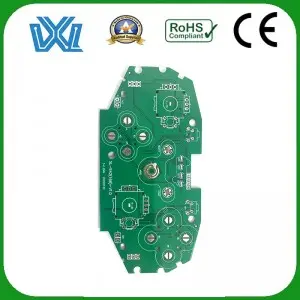Printed circuit boards (PCBs) are the unsung heroes of modern technology, providing functionality to the electronic devices we use every day. While their inner workings are a hot topic, one unique feature is often overlooked – their color. Have you ever wondered why PCBs are predominantly green in color? In this blog, we’ll delve into the historical, technical, and practical factors that have led to the popularity of green PCBs.
Historical Origins:
To understand why green became the color of choice for PCBs, we need to go back to the mid-twentieth century. Early PCBs were made using a substrate called Bakelite, an insulating material with a characteristic brown color. However, as technology improved, the industry turned to more efficient and visually appealing options.
Going green:
In the 1960s, the electronics industry began to use epoxy resin as a substrate material because of its excellent electrical insulation and mechanical properties. These resins also offer an added advantage – the ability to be colored. Green is the color of choice simply because it is affordable and readily available to manufacturers. Provide an attractive finishing touch to the PCB by covering the copper traces with green solder mask ink.
Practical considerations:
In addition to historical factors, practical considerations have also influenced the popularity of green PCBs. Let’s explore two important reasons:
1. Contrast and Sharpness:
Electronics engineers and designers choose green because it contrasts with red, the traditional color of solder mask inks. The contrasting combination of red and green makes it easier to identify any errors in the manufacturing and assembly process. The increased clarity significantly reduces the possibility of errors and improves the overall quality of PCB production.
2. Eye fatigue:
Another rationale behind the choice of green has to do with human factors engineering. Working with electronic devices and PCBs requires hours of staring at intricate circuits and small components. Green is preferred because it is a color that reduces eye strain and strain, allowing technicians to work for long periods of time without discomfort or loss of accuracy. The soothing effect of green on the eyes makes it ideal for long-term use.
Modern alternatives:
While green PCBs have dominated the industry for decades, modern innovations have expanded the palette of PCBs. Today, you can find PCBs in a variety of colors, from blue and red to black and even translucent. These options address specific applications, aesthetic preferences, or unique branding requirements. However, despite the wider range of options available, green remains the most commonly used color due to its cost-effectiveness, familiarity and reliability.
The popularity of green PCBs can be attributed to a combination of historical, technological and practical factors. From its early roots in the affordability and abundance of green epoxy, to its increased clarity and reduced eye strain, the color has become synonymous with the electronics industry. While the market now offers a wider range of color options, it’s safe to say that green PCBs will continue to dominate for the foreseeable future.
Post time: Aug-23-2023

